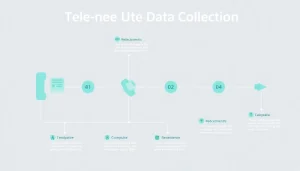Understanding Telephone Data Collection
What is Telephone Data Collection?
Telephone data collection is a systematic approach to gathering information from respondents through telephone interviews. Interviewers reach out to participants, asking predetermined questions to collect quantitative and qualitative data. This method is widely used in various fields, including market research, public opinion polling, and healthcare studies. As an efficient way to collect valuable information, telephone data collection offers a reliable alternative to traditional face-to-face interviews, particularly when researchers need quick results or a broad demographic reach.
Advantages of Using Telephone Surveys
Telephone surveys present numerous advantages over other data collection methods:
- Cost-Effective: Conducting surveys via telephone is generally less expensive than in-person interviews, as it eliminates travel costs and the need for physical materials.
- Speed: Telephone interviews can be executed at a faster pace, yielding quicker results due to the ability to reach numerous respondents within a short time frame.
- Accessibility: Telephone surveys can access a diverse range of participants across various geographical locations, making it easier to gather data from hard-to-reach populations.
- Probing Flexibility: Interviewers can engage respondents effectively, allowing them to ask follow-up questions to clarify responses or gain more in-depth information.
Common Challenges in Telephone Data Collection
As effective as telephone data collection can be, it also presents several challenges:
- Respondent Reluctance: Some individuals may be reluctant to participate in telephone surveys due to privacy concerns or the intrusive nature of unsolicited calls.
- Limited Engagement: The absence of face-to-face interaction can lead to lower engagement levels, impacting the quality and depth of responses.
- Sampling Bias: Certain demographic groups, such as younger populations, may be less likely to respond, resulting in skewed data.
- Time Constraints: Respondents may feel rushed if the survey is lengthy, which could lead to hasty and inaccurate answers.
Methods of Conducting Telephone Surveys
Traditional vs. Computer-Assisted Telephone Interviewing (CATI)
Two primary methods for conducting telephone surveys are traditional methods and Computer-Assisted Telephone Interviewing (CATI). Traditional telephone surveys rely on manual dialing and paper questionnaires, while CATI utilizes computerized systems to streamline the interview process. CATI allows for:
- Automated Dialing: Reduces the time spent on logistical tasks by automatically dialing phone numbers and connecting respondents to interviewers.
- Real-Time Data Entry: Responses are entered directly into a database, minimizing transcription errors and expediting data processing.
- Dynamic Questioning: The system can adjust the line of questioning based on previous responses, allowing for more personalized interactions.
Choosing the Right Methodology
Selecting the appropriate methodology for your telephone survey depends on various factors, including:
- Research Goals: Define clear objectives to determine how complex or simple your questions should be and the required data type.
- Target Audience: Understand your audience’s preferences and accessibility; some demographics respond better to specific methodologies.
- Resources Available: Assess your budget and personnel capabilities; while CATI offers many advantages, traditional methods may be more economical for smaller surveys.
Creating Effective Survey Questions
Crafting effective survey questions is crucial for gathering quality data. Here are some tips for formulating questions:
- Be Clear and Concise: Avoid ambiguity; questions should be easily understood by respondents.
- Use Closed-Ended Questions: These allow for straightforward analysis. However, include a few open-ended questions to gather qualitative insights.
- Avoid Leading Questions: Neutral language helps prevent bias in responses.
- Pre-Test Your Survey: Conduct a pilot survey to identify potential issues and improve question clarity before full deployment.
Best Practices for Telephone Data Collection
Maximizing Respondent Engagement
Engaging respondents is vital to ensure high response rates and quality data. Here are techniques to boost engagement:
- Create a Comfortable Atmosphere: Start with a friendly introduction and explain the purpose of the survey to set a positive tone.
- Use Active Listening: Respond to participants’ answers appropriately and show genuine interest in their responses.
- Keep Surveys Short: Aim to finish surveys in under 15 minutes to minimize fatigue and maintain attention.
Ensuring Data Quality and Accuracy
Maintaining data integrity is crucial for reliable results. Implement the following methods:
- Standardize Training: Provide comprehensive training for interviewers to ensure consistency in approach and understanding of the survey goals.
- Implement Call Monitoring: Regularly review recorded calls to provide feedback and improve interview techniques.
- Develop Clear Protocols: Establish guidelines for handling difficult respondents and managing survey interruptions, ensuring data remains accurate.
Training Interviewers Effectively
Well-trained interviewers play a crucial role in successful telephone data collection. Focus on the following areas during training:
- Knowledge of the Survey: Interviewers should be well-versed in all aspects of the survey, including key objectives, questions, and expected outcomes.
- Communication Skills: Emphasize the importance of clear articulation, active listening, and polite engagement techniques.
- Emotional Intelligence: Train interviewers to recognize and respond to different respondent emotions, adapting their approach accordingly.
Analyzing and Interpreting Data from Telephone Surveys
Tools for Data Analysis
Once data has been collected, it must be analyzed effectively. Common tools include:
- Statistical Software: Programs like SPSS and R can facilitate complex data analysis, providing insights through predictive modeling and statistical testing.
- Data Visualization Tools: Platforms like Tableau allow for the visual representation of data, making it easier to identify trends and communicate findings to stakeholders.
- Qualitative Analysis Software: Using software such as NVivo can help to understand open-ended responses, gaining deeper insights from qualitative data.
Common Data Metrics
When analyzing data from telephone surveys, consider measuring:
- Response Rates: Understand what percentage of contacted participants completed the survey to evaluate engagement and effectiveness.
- Demographic Segmentation: Analyzing data by demographic categories enables you to identify trends and insights that can inform decision-making.
- Qualitative Insights: Assess the themes and sentiments found in open-ended responses to unveil deeper context behind the numbers.
Presenting Findings to Stakeholders
The presentation of survey findings is crucial. Ensure you:
- Tailor the Report: Customize presentations to fit the audience’s interests and levels of understanding, emphasizing key insights relevant to their needs.
- Use Visual Aids: Graphs, charts, and infographics enhance understanding and retention of information.
- Provide Actionable Recommendations: Clearly articulate how the findings can influence decisions and actions moving forward.
Future Trends in Telephone Data Collection
The Role of Technology in Data Collection
Advancements in technology are continuously changing the landscape of data collection. Key trends include:
- Automated Systems: Integration of automated dialing systems and AI-driven interviewers can help researchers improve efficiency and reduce costs.
- Mobile Integration: Increasingly, data collection can involve mobile phones, allowing for a more extensive reach and enabling quick surveys on-the-go.
- Data Security Enhancements: With rising privacy concerns, the implementation of stronger data security measures will become increasingly critical to maintaining trust with respondents.
Adapting to Changing Survey Methods
As survey methodologies evolve, researchers must be adaptable. This involves being responsive to trends, such as:
- Shorter Surveys: Respondents are increasingly pressed for time; therefore, creating concise surveys will lead to higher completion rates.
- Multi-Modal Approaches: Combining telephone surveys with other data collection methods, such as online surveys, can enhance response rates and broaden reach.
Integrating Telephone Surveys with Other Data Collection Techniques
To gather more comprehensive data, integrating telephone surveys with other data collection techniques can be beneficial. Consider:
- Complementary Data Sources: Combine insights from telephone surveys with data from social media, website analytics, and customer feedback to create a multi-faceted understanding of respondent behavior.
- Cross-Methodology Studies: Investigate how results from telephone surveys compare to results obtained through face-to-face or online surveys to validate findings.







